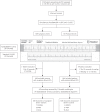Diagnostic Accuracy of a Smartphone-Operated, Single-Lead Electrocardiography Device for Detection of Rhythm and Conduction Abnormalities in Primary Care
- PMID: 31501201
- PMCID: PMC7032908
- DOI: 10.1370/afm.2438
Diagnostic Accuracy of a Smartphone-Operated, Single-Lead Electrocardiography Device for Detection of Rhythm and Conduction Abnormalities in Primary Care
Abstract
Purpose: To validate a smartphone-operated, single-lead electrocardiography (1L-ECG) device (AliveCor KardiaMobile) with an integrated algorithm for atrial fibrillation (AF) against 12-lead ECG (12L-ECG) in a primary care population.
Methods: We recruited consecutive patients who underwent 12L-ECG for any nonacute indication. Patients held a smartphone with connected 1L-ECG while local personnel simultaneously performed 12L-ECG. All 1L-ECG recordings were assessed by blinded cardiologists as well as by the smartphone-integrated algorithm. The study cardiologists also assessed all 12L-recordings in random order as the reference standard. We determined the diagnostic accuracy of the 1L-ECG in detecting AF or atrial flutter (AFL) as well as any rhythm abnormality and any conduction abnormality with the simultaneously performed 12L-ECG as the reference standard.
Results: We included 214 patients from 10 Dutch general practices. Mean ± SD age was 64.1 ± 14.7 years, and 53.7% of the patients were male. The 12L-ECG diagnosed AF/AFL, any rhythm abnormality, and any conduction abnormality in 23, 44, and 28 patients, respectively. The 1L-ECG as assessed by cardiologists had a sensitivity and specificity for AF/AFL of 100% (95% CI, 85.2%-100%) and 100% (95% CI, 98.1%-100%). The AF detection algorithm had a sensitivity and specificity of 87.0% (95% CI, 66.4%-97.2%) and 97.9% (95% CI, 94.7%-99.4%). The 1L-ECG as assessed by cardiologists had a sensitivity and specificity for any rhythm abnormality of 90.9% (95% CI, 78.3%-97.5%) and 93.5% (95% CI, 88.7%-96.7%) and for any conduction abnormality of 46.4% (95% CI, 27.5%-66.1%) and 100% (95% CI, 98.0%-100%).
Conclusions: In a primary care population, a smartphone-operated, 1L-ECG device showed excellent diagnostic accuracy for AF/AFL and good diagnostic accuracy for other rhythm abnormalities. The 1L-ECG device was less sensitive for conduction abnormalities.
Keywords: atrial fibrillation; cardiac arrhythmia; cardiac complexes, premature; cardiac conduction system disease; electrocardiography; medical device; single-lead.
© 2019 Annals of Family Medicine, Inc.
Figures


References
-
- Zwietering P, Knottnerus A, Gorgels T, Rinkens P. Occurrence of arrhythmias in general practice. Scand J Prim Health Care. 1996; 14(4): 244-250. - PubMed
-
- Raviele A, Giada F, Bergfeldt L, et al. European Heart Rhythm Association Management of patients with palpitations: a position paper from the European Heart Rhythm Association. Europace. 2011; 13(7): 920-934. - PubMed
-
- Zwietering PJ, Knottnerus JA, Rinkens PE, Kleijne MA, Gorgels AP. Arrhythmias in general practice: diagnostic value of patient characteristics, medical history and symptoms. Fam Pract. 1998; 15(4): 343-353. - PubMed
-
- Kannel WB, Wolf PA, Benjamin EJ, Levy D. Prevalence, incidence, prognosis, and predisposing conditions for atrial fibrillation: population-based estimates. Am J Cardiol. 1998; 82(8A): 2N-9N. - PubMed
-
- January CT, Wann LS, Alpert JS, et al. American College of Cardiology/American Heart Association Task Force on Practice Guidelines 2014 AHA/ACC/HRS guideline for the management of patients with atrial fibrillation: a report of the American College of Cardiology/American Heart Association Task Force on Practice Guidelines and the Heart Rhythm Society. J Am Coll Cardiol. 2014; 64(21): e1-e76. - PubMed
Publication types
MeSH terms
LinkOut - more resources
Full Text Sources
Medical
